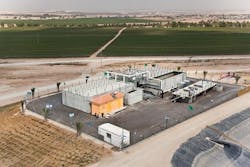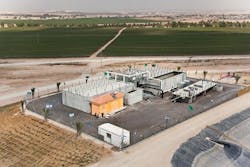By George Pendleton and Jeffrey Griffiths
Utilities estimate that up to 50 percent of a sanitary sewer collection system's footage is comprised of public-private laterals that are rarely inspected, largely due to often-complex public/private ownership issues and limited access. Yet, often significant inflow and infiltration (I/I) within a collection system originates from sources such as laterals located on private property and/or not maintained by the local sewer authority. Any repair of a main sewer, whether through replacement or lining, should include proper investigation of the condition of the laterals to private properties.
In areas where private property I/I sources are high, utilities are challenged to find ways to cost-effectively upgrade aging lateral connections. Historically, municipalities and utilities look at the upfront cost and time to conduct lateral inspections as purely an added cost and an additional, and in most cases unnecessary, step in the process. Instead, they opt for wholesale lateral replacement in an area of certain age or rehabilitating any lateral that "appears" to have infiltration during a conventional CCTV inspection.
The Metropolitan District (MDC) in Hartford, CT, took a different approach, introducing a risk-based lateral replacement inspection program that is founded on thorough inspections to help properly prioritize lateral replacements. Thus far, the program has paid for itself several times over, and has provided MDC with important information to complement its proactive maintenance program.
All MDC customers are responsible to maintain laterals from their home to the main sewer, and if the lateral was in good condition — yet was in need of rodding and cleaning — this was noted to the property owner, which eliminates possible future self-induced backups.
Case for Inspections
Since 1929, MDC has managed the Hartford region's water and sewer systems. The collection system within Hartford was originally developed in the 1850s, and the average installation date is 1930. The majority of the system is a combined system, carrying both stormwater and sanitary flows.
As part of a long-term plan to reduce combined sewer overflows, MDC sought a complete separation of sanitary and stormwater systems in the Franklin Avenue area. In one portion of this area, almost every one of the 1,182 private buildings had one or more of its roof leaders connected to the combined system via building laterals. While the number of laterals varied between neighborhoods, the average roof area connected to the sewer was 70 percent of the total roof area, accounting for 43 percent of the impervious area that contributes run-off to the combined system.
As part of the sanitary and stormwater system separation project, MDC decided to disconnect all private clean water sources. This decision meant that the MDC's contractors would be installing a new lateral from the new collection piping in the road to private property and into almost every building. While regulatory compliance initiated the project, MDC also sought to eliminate backups into private dwellings and reduce street flooding and overflows into Wethersfield Cove and the Connecticut River.
MDC realized that construction activities for a project of this scale would have a significant impact on local residents and businesses. Therefore, the agency wanted to identify and prioritize all potential rehabilitations or replacements of their infrastructure that might be required within the next 10 to 20 years (expected life of the roadway) to avoid reopening the roads for repairs. The proposal included the replacement of all 1,182 existing sewer laterals within the project area.
Considering that most of the pipes in this area were installed between 1900 and 1920, the agency reasonably assumed that most of the laterals and their connections would have deteriorated over the past 100 years.
Kleinfelder, the utility's engineer, prepared a simple cost-benefit analysis. Engineers assumed the cost of a lateral replacement was about $6,000, and the inspection program cost would be approximately $300,000 (approximately $270 per lateral). If the inspection found 54 laterals that did not need replacement, the program would pay for itself. Given the potential savings that could be realized, MDC quickly understood the benefit of conducting inspections and removing laterals from the replacement list.
Investigative Techniques
Historically, utilities have rarely inspected laterals largely due to often-complex public/private ownership issues, limited access and unreliable inspection technologies. While ownership issues and limited access haven't changed, inspection technologies have improved considerably.
The most common investigative method is a visual inspection using a closed-circuit television (CCTV) camera. Pushrod CCTV systems have been on the market for decades and while they are a necessary tool, they require lateral cleanouts and/or right of entry to private property access points (e.g., downspouts, roof vents, toilets). The least invasive and most cost-effective investigative method is a CCTV inspection from the mainline sewer using a robotic crawler.
Mainline lateral systems have been on the market for about a decade, but recent technological improvements make them the preferred inspection method. Not only are more laterals accessible with improved technology, but they can be located with global positioning system (GPS) to update mapping and geographic information system (GIS) records.
Hydromax USA (HUSA) conducted all lateral inspections using a mainline M-series lateral launching system manufactured by Rausch Electronics. Since MDC had cleaned and televised all of its main pipes within the prior three years, the lines were relatively free of sediment, grease or other materials blocking or fouling the robotic CCTV unit. Kleinfelder used ESRI GIS mapping software to evaluate the size, location and status of the existing laterals, and then transmitted this information to HUSA for the required CCTV activities.
Structural Rating System
The HUSA field crews were able to fully inspect 1,052 laterals and partially inspect all but 30 of the remaining laterals. Partial inspections were primarily due to offset joints, protruding taps and roots. The high success rate was largely due to new improvements in inspection technologies and well-trained operators. HUSA recorded conditions according to the National Association of Sewer Service Companies (NASSCO) Lateral Assessment and Certification Program (LACP), including evaluating performance for structural integrity, root intrusion and infiltration.
Each lateral segment received a structural rating, a maintenance rating and an overall rating. Structural issues included cracks, fractures, breaks, holes, deformations, collapses, joint offsets, and surface damage. Kleinfelder recommended replacing laterals above a structural rating of 3,000, which included 330 out of 1,168 laterals — or 28 percent.
A maintenance code for roots presented another reason for lateral replacement. The best, most environmentally friendly method for permanently fixing a root problem requires replacing the 3-foot unit length clay pipe with new PVC pipe that has fewer, tighter joints. While codes are used to describe the ingress of roots, defects in the laterals indicate the extent of the root ingress (roots fine, roots tap, roots medium and roots ball). However small a presence, any root will grow into a larger maintenance issue if allowed to remain. In this instance, several laterals contained more than one root defect. Therefore, Kleinfelder recommended replacing all 374 laterals with root defects.
Results from the HUSA inspection included 108 lateral segments given the status of "cannot complete," indicating that the field survey for these laterals was abandoned prior to reaching the required 30 feet. Segments in this category contain defects such as large debris, lateral caps, rocks in the pipe and other miscellaneous defects. Review of these defects revealed 40 laterals as candidates for replacement.
In addition, the lack of visual data frustrated the assessment of the condition of 39 "cannot complete" laterals. To limit the risk of misidentifying these laterals where significant structural or root issues are present but unseen, Kleinfelder recommended 79 "cannot complete" laterals as candidates for replacement.
Calculating overlap between the structural ratings greater than 3,000, maintenance codes for root problems, and incomplete videos yielded 646 laterals that needed replacement, or 50 percent of the total number of laterals initially targeted for replacement.
Inspection and analysis revealed that 514 laterals were deemed in satisfactory operating condition and not in current need of replacement, representing a savings of half the anticipated cost at a minimal cost for inspection. In addition, MDC can be confident that those remaining laterals will remain adequate for some time, coinciding with the remaining useful life of the roadway.
Program Cost Savings
For MDC, the average bid price for lateral replacement in the right-of-way including restoration of pavement, curbing and sidewalk was approximately $10,000 per lateral. This unit cost does not include general conditions, traffic control or other incidental costs. Therefore, the initial plan of replacing the public portion (35 feet on average) of all 1,182 laterals would have conservatively cost nearly $12 million.
The cost of the risk-based lateral inspection program was about $300,000 to inspect 1,160 laterals, equating to a final, fully burdened cost of approximately $270 per lateral. To break even, the project team needed to identify only 30 laterals as satisfactory. In actuality, 514 laterals were deemed to be in satisfactory condition. Bottom line, the cost to perform the lateral inspections was an order of magnitude less than the potential cost of total replacement.
On this project, MDC increased the cost of lateral replacement estimates because of the urban conditions and other requirements. As construction costs decrease, the return on investment for a risk-based lateral inspection program might not be as dramatic.
About the Authors: George Pendleton, P.E., is a project manager with Kleinfelder, based in Rocky Hill, CT. He may be contacted at [email protected]. Jeffrey Griffiths is Regional Manager for Hydromax USA, based in Newport News, VA. He may be contacted at [email protected].
More WaterWorld Current Issue Articles
More WaterWorld Archives Issue Articles





